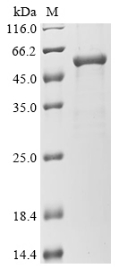Recombinant Human Gasdermin-D (GSDMD) is produced in E.coli and contains the complete protein sequence spanning amino acids 1 to 484. The protein carries an N-terminal 6xHis-tag that helps with purification and detection processes. SDS-PAGE analysis confirms the product reaches over 85% purity, which appears sufficient for most research applications. This product is meant strictly for research purposes and should not be used for diagnostic or therapeutic work.
Gasdermin-D plays a key role in pyroptosis, a type of programmed cell death tied to inflammatory responses. When caspases activate GSDMD, the protein creates pores in cell membranes. This leads to cell breakdown and triggers the release of inflammatory cytokines. Research on GSDMD may help scientists better understand immune response pathways and could shed light on inflammatory diseases and cancer mechanisms.
Potential Applications
Note: The applications listed below are based on what we know about this protein's biological functions, published research, and experience from experts in the field. However, we haven't fully tested all of these applications ourselves yet. We'd recommend running some preliminary tests first to make sure they work for your specific research goals.
The human GSDMD is a complex protein that requires precise folding for its function as a pore-forming protein in pyroptosis. Its bioactivity depends on caspase-mediated cleavage (at Asp275/276) and subsequent oligomerization into membrane pores. E. coli lacks the eukaryotic chaperones and post-translational modification machinery needed for proper folding of such complex proteins. While the His tag may improve solubility, it cannot compensate for fundamental folding limitations. The protein's activity is explicitly unknown, and without experimental validation (e.g., caspase cleavage assays or liposome permeabilization tests), it cannot be assumed to be correctly folded or bioactive.
1. Protein-Protein Interaction Studies Using His-Tag Pull-Down Assays
The His tag enables pull-down assays to identify potential binding partners. However, if GSDMD is misfolded, interactions may be non-physiological. The full-length structure is necessary for some interactions, but does not guarantee correct folding. Validate any identified partners using caspase-cleaved, active GSDMD or confirm with co-immunoprecipitation from mammalian cells expressing endogenous GSDMD.
2. Antibody Development and Validation
This application is suitable. The recombinant GSDMD can serve as an immunogen for generating antibodies against linear epitopes, even if misfolded. The high purity supports consistent immunization. However, antibodies generated may not recognize conformational epitopes of native, caspase-cleaved GSDMD. Validate antibody specificity against endogenous GSDMD from human cells, particularly its cleaved forms.
3. Biochemical Characterization and Biophysical Analysis
Suitable for basic biophysical analysis (e.g., thermal stability, oligomerization state via SEC). However, data may not reflect native GSDMD behavior, especially regarding pore-forming capability. The protein may show aggregation rather than functional oligomerization without proper cleavage. Use techniques like circular dichroism to assess secondary structure, but interpret results cautiously.
4. In Vitro Protease Cleavage Assays
This is the most feasible application if cleavage is successful. The His tag facilitates purification of cleavage products. However, even if caspases cleave the protein correctly, the cleaved fragments may not form functional pores if misfolded. Validate cleavage efficiency and pore-forming activity in liposome assays before functional conclusions.
Final Recommendation & Action Plan
Before using this recombinant GSDMD for functional studies, validate its folding and bioactivity through a stepwise approach: 1) Test caspase cleavage: Incubate with active caspase-1/4/5 and analyze cleavage by Western blot; 2) Assess pore formation: If cleaved, test pore-forming activity in liposome leakage assays or erythrocyte lysis assays; 3) Check oligomerization: Use native PAGE or SEC-MALS to examine oligomer formation post-cleavage. If the protein shows cleavage and pore-forming activity, proceed with interaction studies; if inactive, limit use to antibody production or biochemical characterization. For reliable results, consider expressing GSDMD in mammalian cells that can provide a proper folding environment. Always include appropriate controls (e.g., known active GSDMD) when possible.






